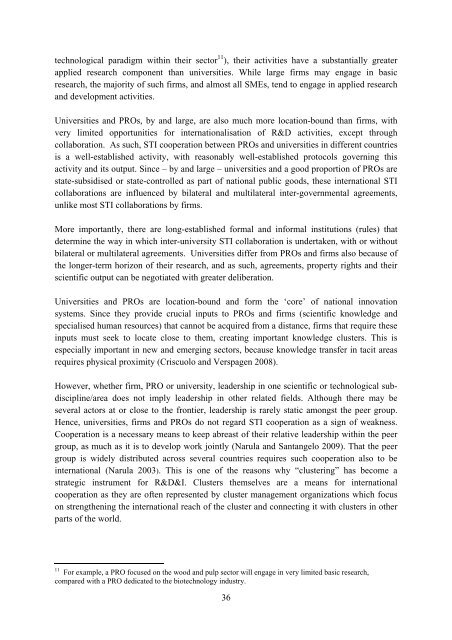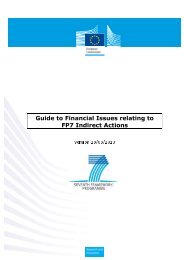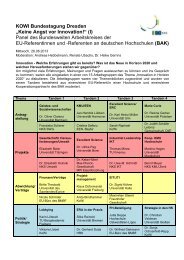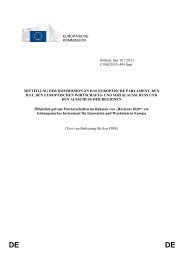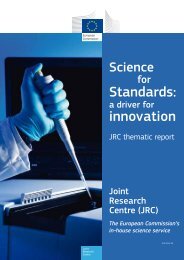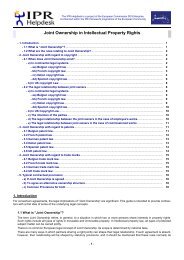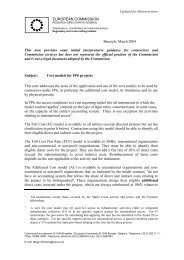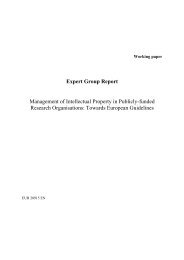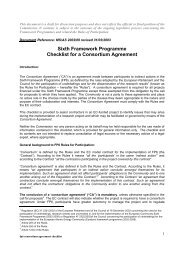Draft Report of the Expert Group on International STI Cooperation to ...
Draft Report of the Expert Group on International STI Cooperation to ...
Draft Report of the Expert Group on International STI Cooperation to ...
You also want an ePaper? Increase the reach of your titles
YUMPU automatically turns print PDFs into web optimized ePapers that Google loves.
technological paradigm within <str<strong>on</strong>g>the</str<strong>on</strong>g>ir sec<strong>to</strong>r 11 ), <str<strong>on</strong>g>the</str<strong>on</strong>g>ir activities have a substantially greater<br />
applied research comp<strong>on</strong>ent than universities. While large firms may engage in basic<br />
research, <str<strong>on</strong>g>the</str<strong>on</strong>g> majority <str<strong>on</strong>g>of</str<strong>on</strong>g> such firms, and almost all SMEs, tend <strong>to</strong> engage in applied research<br />
and development activities.<br />
Universities and PROs, by and large, are also much more locati<strong>on</strong>-bound than firms, with<br />
very limited opportunities for internati<strong>on</strong>alisati<strong>on</strong> <str<strong>on</strong>g>of</str<strong>on</strong>g> R&D activities, except through<br />
collaborati<strong>on</strong>. As such, <strong>STI</strong> cooperati<strong>on</strong> between PROs and universities in different countries<br />
is a well-established activity, with reas<strong>on</strong>ably well-established pro<strong>to</strong>cols governing this<br />
activity and its output. Since – by and large – universities and a good proporti<strong>on</strong> <str<strong>on</strong>g>of</str<strong>on</strong>g> PROs are<br />
state-subsidised or state-c<strong>on</strong>trolled as part <str<strong>on</strong>g>of</str<strong>on</strong>g> nati<strong>on</strong>al public goods, <str<strong>on</strong>g>the</str<strong>on</strong>g>se internati<strong>on</strong>al <strong>STI</strong><br />
collaborati<strong>on</strong>s are influenced by bilateral and multilateral inter-governmental agreements,<br />
unlike most <strong>STI</strong> collaborati<strong>on</strong>s by firms.<br />
More importantly, <str<strong>on</strong>g>the</str<strong>on</strong>g>re are l<strong>on</strong>g-established formal and informal instituti<strong>on</strong>s (rules) that<br />
determine <str<strong>on</strong>g>the</str<strong>on</strong>g> way in which inter-university <strong>STI</strong> collaborati<strong>on</strong> is undertaken, with or without<br />
bilateral or multilateral agreements. Universities differ from PROs and firms also because <str<strong>on</strong>g>of</str<strong>on</strong>g><br />
<str<strong>on</strong>g>the</str<strong>on</strong>g> l<strong>on</strong>ger-term horiz<strong>on</strong> <str<strong>on</strong>g>of</str<strong>on</strong>g> <str<strong>on</strong>g>the</str<strong>on</strong>g>ir research, and as such, agreements, property rights and <str<strong>on</strong>g>the</str<strong>on</strong>g>ir<br />
scientific output can be negotiated with greater deliberati<strong>on</strong>.<br />
Universities and PROs are locati<strong>on</strong>-bound and form <str<strong>on</strong>g>the</str<strong>on</strong>g> ‘core’ <str<strong>on</strong>g>of</str<strong>on</strong>g> nati<strong>on</strong>al innovati<strong>on</strong><br />
systems. Since <str<strong>on</strong>g>the</str<strong>on</strong>g>y provide crucial inputs <strong>to</strong> PROs and firms (scientific knowledge and<br />
specialised human resources) that cannot be acquired from a distance, firms that require <str<strong>on</strong>g>the</str<strong>on</strong>g>se<br />
inputs must seek <strong>to</strong> locate close <strong>to</strong> <str<strong>on</strong>g>the</str<strong>on</strong>g>m, creating important knowledge clusters. This is<br />
especially important in new and emerging sec<strong>to</strong>rs, because knowledge transfer in tacit areas<br />
requires physical proximity (Criscuolo and Verspagen 2008).<br />
However, whe<str<strong>on</strong>g>the</str<strong>on</strong>g>r firm, PRO or university, leadership in <strong>on</strong>e scientific or technological subdiscipline/area<br />
does not imply leadership in o<str<strong>on</strong>g>the</str<strong>on</strong>g>r related fields. Although <str<strong>on</strong>g>the</str<strong>on</strong>g>re may be<br />
several ac<strong>to</strong>rs at or close <strong>to</strong> <str<strong>on</strong>g>the</str<strong>on</strong>g> fr<strong>on</strong>tier, leadership is rarely static am<strong>on</strong>gst <str<strong>on</strong>g>the</str<strong>on</strong>g> peer group.<br />
Hence, universities, firms and PROs do not regard <strong>STI</strong> cooperati<strong>on</strong> as a sign <str<strong>on</strong>g>of</str<strong>on</strong>g> weakness.<br />
Cooperati<strong>on</strong> is a necessary means <strong>to</strong> keep abreast <str<strong>on</strong>g>of</str<strong>on</strong>g> <str<strong>on</strong>g>the</str<strong>on</strong>g>ir relative leadership within <str<strong>on</strong>g>the</str<strong>on</strong>g> peer<br />
group, as much as it is <strong>to</strong> develop work jointly (Narula and Santangelo 2009). That <str<strong>on</strong>g>the</str<strong>on</strong>g> peer<br />
group is widely distributed across several countries requires such cooperati<strong>on</strong> also <strong>to</strong> be<br />
internati<strong>on</strong>al (Narula 2003). This is <strong>on</strong>e <str<strong>on</strong>g>of</str<strong>on</strong>g> <str<strong>on</strong>g>the</str<strong>on</strong>g> reas<strong>on</strong>s why “clustering” has become a<br />
strategic instrument for R&D&I. Clusters <str<strong>on</strong>g>the</str<strong>on</strong>g>mselves are a means for internati<strong>on</strong>al<br />
cooperati<strong>on</strong> as <str<strong>on</strong>g>the</str<strong>on</strong>g>y are <str<strong>on</strong>g>of</str<strong>on</strong>g>ten represented by cluster management organizati<strong>on</strong>s which focus<br />
<strong>on</strong> streng<str<strong>on</strong>g>the</str<strong>on</strong>g>ning <str<strong>on</strong>g>the</str<strong>on</strong>g> internati<strong>on</strong>al reach <str<strong>on</strong>g>of</str<strong>on</strong>g> <str<strong>on</strong>g>the</str<strong>on</strong>g> cluster and c<strong>on</strong>necting it with clusters in o<str<strong>on</strong>g>the</str<strong>on</strong>g>r<br />
parts <str<strong>on</strong>g>of</str<strong>on</strong>g> <str<strong>on</strong>g>the</str<strong>on</strong>g> world.<br />
11 For example, a PRO focused <strong>on</strong> <str<strong>on</strong>g>the</str<strong>on</strong>g> wood and pulp sec<strong>to</strong>r will engage in very limited basic research,<br />
compared with a PRO dedicated <strong>to</strong> <str<strong>on</strong>g>the</str<strong>on</strong>g> biotechnology industry.<br />
36


